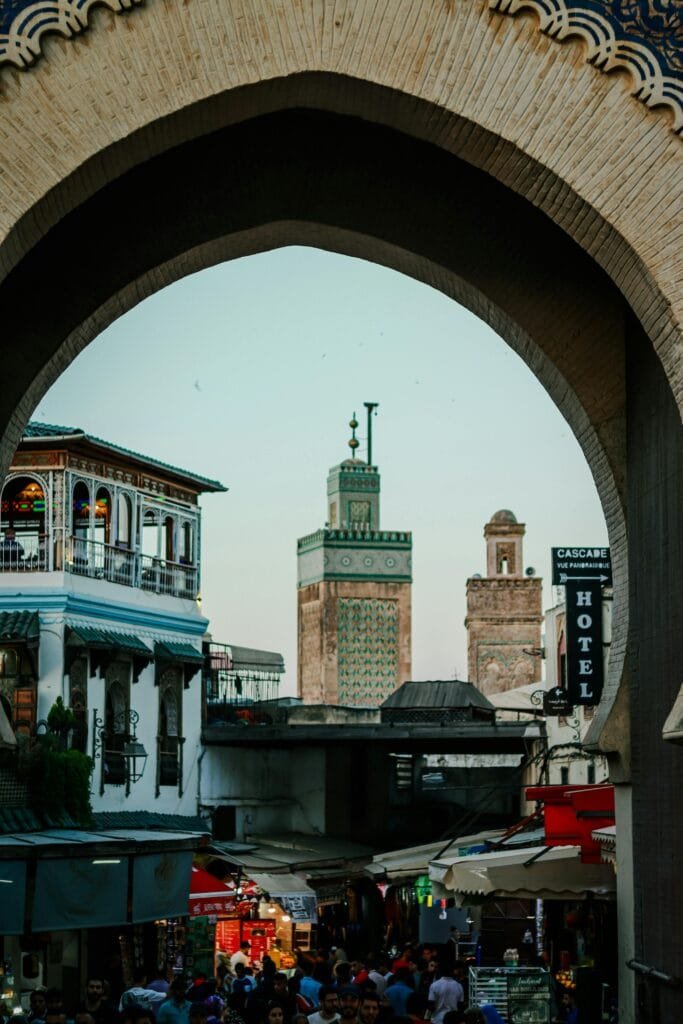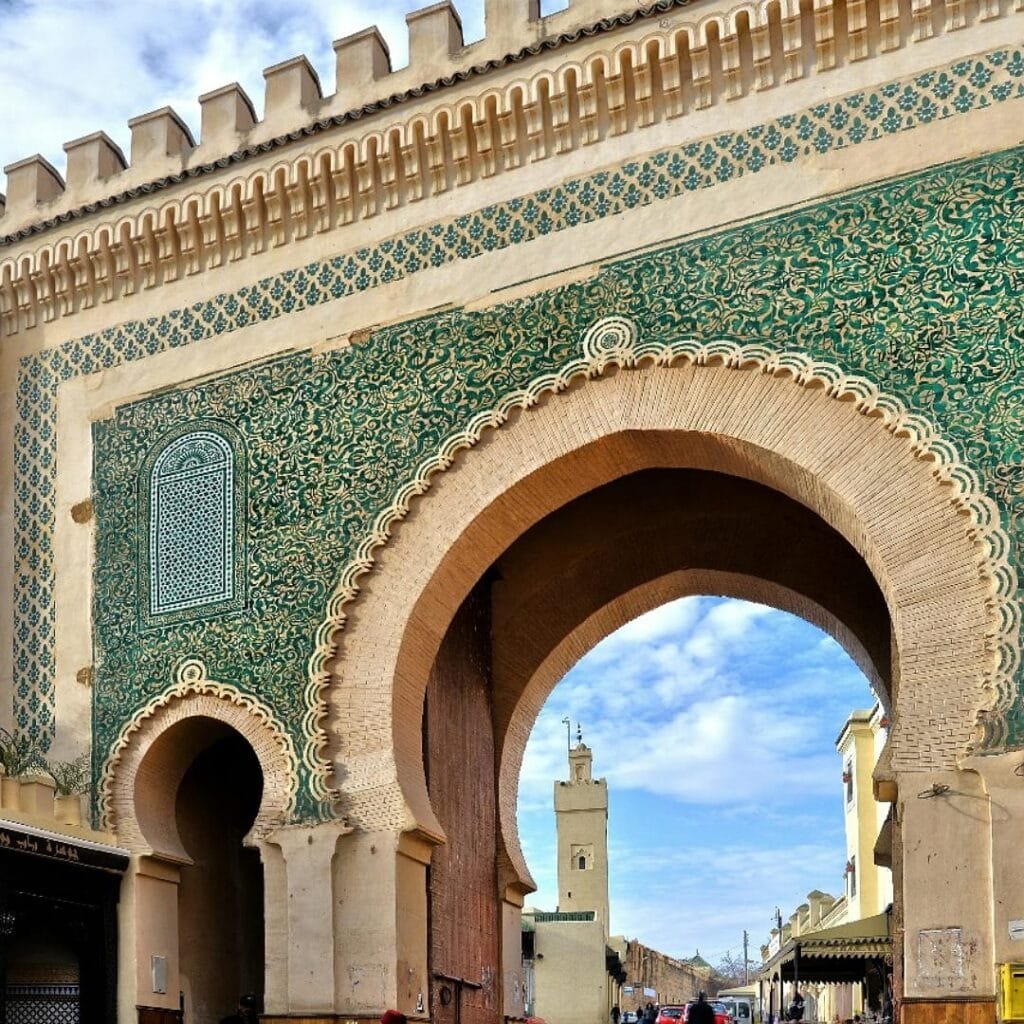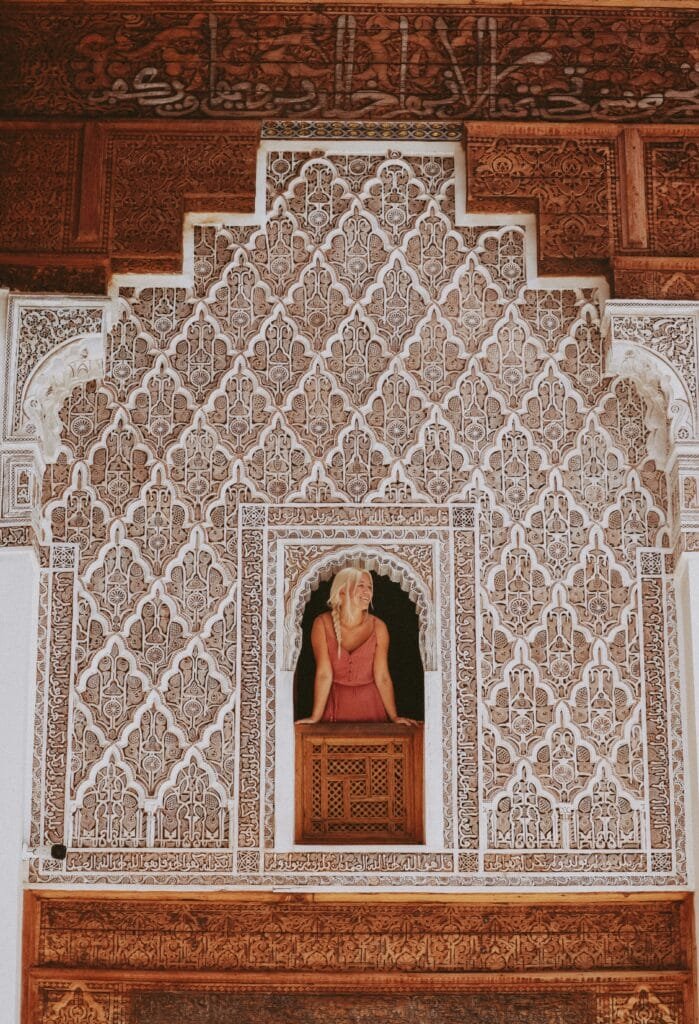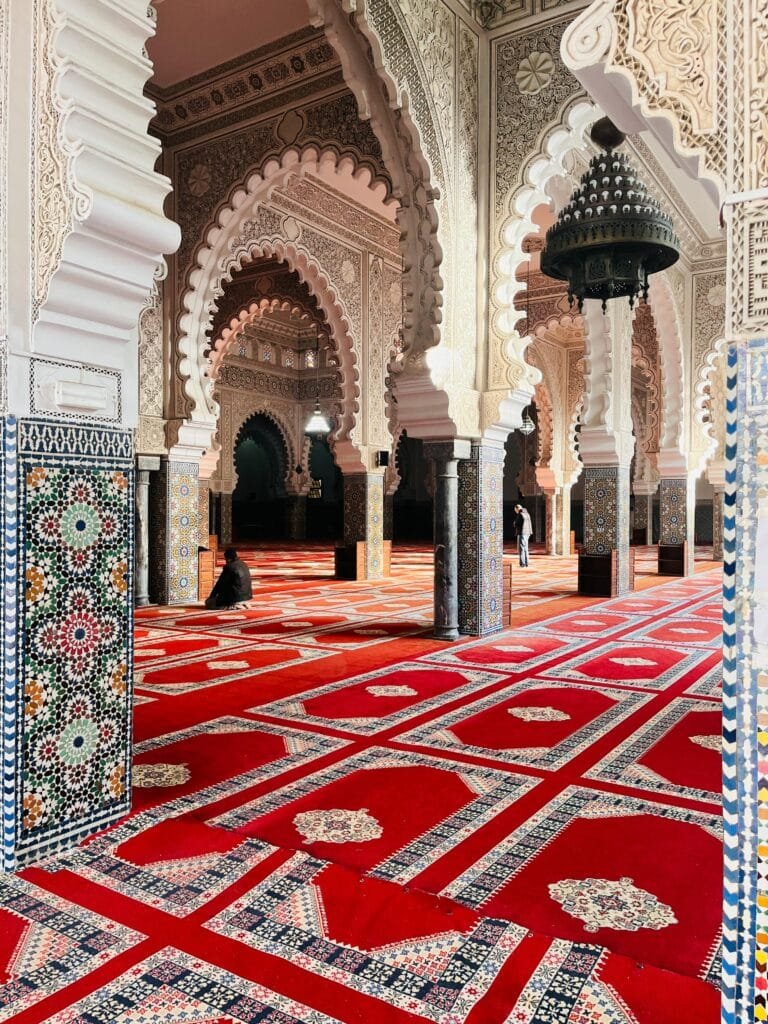The world’s largest car-free urban area sits within the Medina of Fez, offering adventurous travelers an exceptional destination. This 9th-century UNESCO World Heritage site holds countless hidden treasures along its winding paths, though most tourists rarely venture beyond the main routes.
As someone born and raised in the heart of Fez, just steps away from the historic Chouara Tanneries, I’ve spent my entire life surrounded by the ancient walls and winding alleys of this incredible city. I still live here, in the old medina, where every corner holds a memory and every stone whispers a story.
Over the years, exploring Fez has led me to places most tourists never see. While landmarks like Chouara Tanneries and the University of Al Quaraouiyine, founded in 859 AD, are essential stops, the real magic of Fez lies in its hidden corners.
Down forgotten alleyways, you’ll find quiet artisan workshops where generations of craftsmen work in silence, creating beautiful pieces by hand. On secret rooftops, there are breathtaking viewpoints where the sunsets paint the city in gold — moments of peace that most guidebooks overlook.
The best time to discover these hidden gems is between March and May or October and November, when the weather is mild and the city is not too crowded. This is when Fez reveals its true soul — calm, welcoming, and full of wonder.
Living here, I see Fez not just as a destination, but as a way of life. And I believe that those who come with open hearts can experience a side of the city that most never imagine.
Wander the Forgotten Alleys of the Medina
The real magic of Fez lies beyond its tourist-packed main streets. The old Medina’s maze has over 9,000 alleys and narrow streets . This creates a world where real daily life plays out in fascinating ways. These hidden pathways are a great way to get the most rewarding experiences in Fez Morocco for travelers who want true cultural immersion.
How to find the quietest streets
The most peaceful parts of the Medina sit in its residential areas, away from the busy souks near Bab Boujloud (Blue Gate). The timing makes all the difference to find these quiet spots. Friday mornings are exceptionally peaceful as locals head to prayers. This makes it the best day to explore without interruption.
You’ll want to move perpendicular to the main streets to find real quiet. The deeper you go into the bowl-shaped Medina, the more residential and authentic it feels. The uphill paths often take you to less-visited gates and edge areas where tourist crowds thin out.
Local guides say the area between the Karaouine mosque and the northeastern gates gives you the most peaceful exploration. You’ll see neighbors saying hello, friends playing backgammon outside, and glimpses of everyday Fassi life that most tourists never see.
What makes these alleys special
These hidden alleys of Fez show a genuine character that sets them apart from other commercialized Moroccan spots. Fez’s hills create a three-dimensional maze unlike Marrakech’s flat medina. This means surprising views pop up around every corner.
The quiet passages tell their stories through architecture – weathered facades, metal-studded wooden doors, and small, scattered windows that have seen centuries pass by. The narrow spaces (some barely fit two people) create a close feeling where sounds, smells, and colors become more intense.
These alleys stand out because they’re living spaces, not tourist spots. The Medina is nowhere near as touristy as Marrakech’s, and real life happens right in front of you. So in these quiet areas, you’ll catch women cooking, men getting haircuts, and kids playing soccer – real moments you’d miss on the main tourist paths.
The old design creates amazing light effects throughout the day. Sunbeams cut through narrow gaps to light up walls with patterns that keep changing. This natural light show turns simple alleyways into magical spaces, especially early morning and late afternoon.





Tips for exploring without getting lost
Getting lost in Fez’s Medina isn’t just possible – it’s pretty much guaranteed. In spite of that, you can explore with confidence using these practical tips:
Use the “bowl” geography: It’s worth mentioning that the Medina looks like a bowl – downhill streets lead to the center, while uphill paths usually take you to outer gates.
Identify personal landmarks: Look for unique shops, architectural features, or street corners you’ll recognize when coming back.
Learn the Blue Gate route: Know the way between your room and Bab Boujloud (Blue Gate) well, as this becomes your main reference point
My best advice from years of wandering these alleys: wear comfy clothes and carry water, but don’t worry too much about staying perfectly oriented. The best finds often happen when you’ve gone off track.
A guide can help you feel safe and relaxed, especially after dark. Having one on your first day helps build confidence before you explore on your own. Many riads also help you get back from restaurants and major sites – this helps a lot when walking through dark alleys at night.
These hidden passages deserve respect and curiosity. The most authentic alleys are where people live their daily lives. A smile, a simple Arabic greeting (“As-salamu alaykum”), and respect for privacy will open doors to experiences most visitors never see.
Discover the Hidden Courtyards of Fes
The greatest treasures of Fez’s medina hide behind its simple exterior walls – beautiful courtyards that are the lifeblood of traditional Moroccan homes. A magical sense of wonder awaits those lucky enough to peek behind these ancient doors, where plain exteriors give way to stunningly decorated spaces inside.
Why courtyards matter in Moroccan culture
The courtyard (or riad) design shows core Moroccan values that focus on privacy and family life. Moroccan houses traditionally faced inward, which created a thoughtful divide between public and private spaces. This wasn’t just about looks – it showed Islamic social values that placed high importance on family privacy and created clear boundaries between family areas and guest spaces.
These central open spaces serve many purposes at once. They bring nature right into the home and create cool spots that offer relief from Fez’s hot climate. The clever design lets sunlight and fresh air flow through the entire house. On top of that, it ensures people can enjoy the beauty and peace from every room since all doorways and windows open to the courtyard.
These courtyards are the soul of Moroccan home life – they’re spaces that delight all senses where families gather, host guests, and escape from the busy world outside. A traveler who stayed at a Fez riad said it best: “There’s something almost hypnotic about these spaces that invites you to slow down and be present”.
Where to find the most beautiful ones
The most spectacular courtyards lie beyond tourist hotspots. Here are some gems worth visiting:
- Riad Belghazi: This traditional riad sits in the upper medina with a spacious courtyard filled with citrus trees and centuries-old mosaic tiles. The city views from its rooftop make the 50+ stair climb worth every step.
- Palais Amani: Near the old city’s edge, this hidden treasure shows off striking blue and white tiled pillars and detailed wooden shutters around a lush garden. The 1930s Art Deco touches give this Arabian-Andalusian style riad its unique charm.
- Dar Attajalli: Kleo, a German expat, owns this carefully restored house that has one of Fez’s most beautiful interior fountains. The cozy courtyard features detailed bartal (carved plasterwork) and natural paints on preserved cedar wood.
- Fondouk el Nejjarine: This wood museum’s impressive courtyard often goes unnoticed by visitors. Beyond its artifacts, you’ll find amazing rooftop views across the medina.
The courtyards look especially magical in spring when orange blossoms fill the air with perfume and ivy-covered walls burst into color. Many have central fountains surrounded by green plants, creating peaceful havens away from Fez’s noise and heat.





Respecting privacy while exploring
The difference between public and private spaces remains crucial in today’s Moroccan culture. The facts show that “Morocco is a country that keeps the public and the private very much distinct”. Visitors should approach these intimate spaces with cultural awareness. Here are some respectful ways to explore authentic courtyards:
Book a stay at a traditional riad to experience courtyard living yourself. You could also visit restaurants in restored riads – they showcase stunning courtyard architecture while welcoming visitors.
Take off your shoes when entering a Moroccan home if you’re invited. Bringing your host a small gift shows good manners. Note that Moroccans consider the left hand impure; use your right hand to greet people and make gestures.
Privacy remains the lifeblood of Moroccan home life. Don’t peek into doorways uninvited or take photos of residents without asking. While cities like Casablanca and Marrakesh have modernized, Fez keeps its traditional values strong.
The sort of thing I love about Fez, Morocco, is finding these hidden courtyards – they offer a rare glimpse into this ancient city’s authentic heart, where beauty, privacy, and tradition blend perfectly together.
Visit the Overlooked Mosques and Shrines
The grand Qarawiyyin Mosque attracts many visitors, yet the true spiritual essence of Fez lives in its quiet religious sites tucked away in the medina. The city has managed to keep its powerful status as a religious capital. Its mosques serve not just as prayer spaces but also as educational and community hubs.
Mosques tourists often miss
Beyond the prominent Qarawiyyin and Bou Inania Madrasa, several remarkable mosques remain hidden from tourist paths:
The Rcif Mosque sits quietly in the medina’s heart and radiates peace despite its historical value. Its elegant yet simple design shows off traditional Moroccan craftsmanship and gives visitors a real taste of religious life away from busy tourist spots.
The Mosque of the Andalusians (Masjid Al-Andalus) stands as one of Fez’s oldest spiritual treasures from 859-860. Maryam al-Fihriya built it just a year after her sister Fatima created Al-Qarawiyyin. This mosque reflects the deep Andalusian roots in Fez’s story. Its name honors about 800 Andalusian families who escaped Cordoba in 818 and helped build this sacred place.
The mosque started small with seven vaulted arcades and a modest courtyard. It grew in importance about 100 years later when it became the city’s main spot for Friday sermon prayers. The building went through major changes during the Almohad Dynasty (1147-1248). A large northern gate topped with two domes appeared between 1203-1207.
The Al-Attarine Madrasa, though actually a school rather than a mosque, lets non-Muslim visitors see Islamic architectural beauty up close. Sultan Abu Sa’id Uthman II (1323-1325) commissioned this 14th-century gem near the spice market on Rue Talaa Kebira. Its stunning courtyard showcases classic Marinid patterns.
The Abu al-Hasan Mosque from 1341 and the Chrabliyine Mosque from 1342 show off excellent Marinid religious architecture that most visitors never see.
Small shrines with big stories
Fez’s zawiyas are just as fascinating but often missed. These religious complexes blend mosque, school, and shrine functions:
The Zawiya of Moulay Idris II holds the tomb of Idris II, Morocco’s ruler from 807 to 828 and Fez’s founder. This shrine sits in Fes el-Bali’s heart and ranks among Morocco’s holiest places. People believe Idris II’s zawiya brings blessings to city newcomers, young boys before circumcision, and women needing help during childbirth.
Morocco’s biggest moussem (Sufi religious festival) happens at this zawiya and has run for centuries. Traditional merchant and artisan guilds march through the city to Idris II’s mausoleum. Each guild brings gifts including the keswa, a large textile with Qur’anic verses that covers the catafalque.
The Zawiya of Sidi Ahmad al-Tijani works as both meeting spot and final resting place for Shaykh Ahmad Tijani (1735-1815). This prominent scholar started the Tijani tariqa (Sufi order). The building’s outside looks like Moroccan madrasa courtyards with glazed tiles and detailed stucco and wood carvings.
The domed mausoleums of the Seba’tul Rijaal (Seven Saints of Fez) rest outside the medina walls at Bab al Futuh cemetery. These include Qaasim al Kasaasi (d.1672), who led the Shadhili Darqawi spiritual line, and Sidi Ali ibn Harzihim (d.1163), the 12th-century Amazigh scholar from Qarawiyyin University.
Many religious sites don’t allow non-Muslim visitors inside, but you can still enjoy their beauty from outside. The Zawiya of Moulay Idris II’s detailed tilework and carved wooden doors look stunning from nearby streets, where you feel the sacred atmosphere beyond the shrine’s walls.
Travelers who want to learn about Morocco’s spiritual side can join private Sufi ceremonies in some riads. These events feature music and tea rituals that show the mystical side of Islam, where followers start a journey to predict the divine.





Explore the Artisan Workshops Off the Main Path
Away from the tourist crowds, Fez holds a rich source of authentic artisan workshops where age-old crafts still thrive. These hidden creative spaces are a great way to get genuine cultural experiences and unique handcrafted souvenirs.
Where real craftsmanship happens
Fez’s artistic heritage comes alive in ancient fondouks – traditional merchants’ inns that have been transformed into bustling artisan hubs. Place Lalla Yeddouna stands as the centerpiece of an ambitious restoration project that has brought new life to 27 historic monuments, some dating back to the 11th century. These restored fondouks provide discounted rent to vetted Moroccan artisans, which helps authentic local crafts flourish.
Fonduk Staounyine, just northeast of the Quaraouiyine Mosque, specializes in traditional weaving. The 13th-century Chemmaine Fonduk nearby displays rare handicrafts like wooden hammam buckets and gilded leather. At Ain Nokbi in Fez, new potter workshops give artisans better working conditions with air extraction and filtering systems.
The outskirts of the city let you see the complete process behind Fez’s famous blue-and-white ceramics. You can watch artisans shape clay on foot-operated potter’s wheels and fire pieces in traditional kilns.
How to support local artisans
Your support directly affects artisans’ livelihoods and helps preserve their traditional skills. Workshops like Timeless Fez provide hands-on learning opportunities that help preserve endangered artisanal crafts such as horn making, copper etching, and traditional pottery.
Anou Cooperative shines as a genuine artist-run space where artisans set their own prices and receive about 80% of the purchase price. This approach eliminates middlemen from sales and ensures fair compensation for creators.
Here are meaningful ways to participate in local craftsmanship:
- Create your own masterpieces alongside skilled artisans who have perfected their craft over generations.
- Visit artisan schools like the one in Batha that teaches traditional trades alongside modern skills like literacy, marketing, and computing.
- Buy items at fonduks instead of souks since fonduk vendors sell only authentic local goods, unlike some souk merchants who may stock imported products.
What to look for in handmade goods
Fez earned its reputation as Morocco’s artisanal capital through centuries of refined craftsmanship. Knowledge about these special items will boost your shopping experience and appreciation of Fassi heritage.
When scrutinizing pottery, look for the distinctive blue patterns unique to Fez (different from yellows in Safi and greens in Meknes). Authentic zellige mosaics show handcrafted imperfections – tonal variations, small chips, and slight size differences set them apart from machine-made copies.
Quality leather goods from ancient tanneries show careful processing through multiple stages. The leather feels supple yet durable, with natural variations in texture and color that showcase its handcrafted nature.
Traditional crafts need time and dedication to master. Without doubt, the most precious souvenirs tell stories of cultural significance – from ceramic pieces showing Andalusian influences to textiles featuring Berber motifs and traditional dyeing techniques.
By learning about these off-path workshops, you’ll find unique experiences in Fez and help preserve Morocco’s rich artistic heritage for future generations.




Relax in Secret Gardens and Green Spaces
The bustling medina’s hidden treasures are amazing to explore, but you’ll need a peaceful green space to catch your breath. Fez’s secret gardens give you a quiet break from the ancient city’s sensory overload. These peaceful spots let you watch local life unfold at a slower pace.
Lesser-known alternatives to Jnan Sbil
Jnan Sbil Garden stands as Fez’s crown jewel with its sprawling 8 hectares near the medina entrance. Yet several hidden gardens offer equally magical experiences without the tourist crowds.
The Latin America Garden surprises visitors with its vast green spaces and tall trees that create natural shade. Nature lovers and anyone seeking peace will love its quiet atmosphere – a perfect spot for thoughtful walks.
Behind plain walls lies a hidden gem – the Batha Museum Gardens that most visitors miss while rushing to see the museum artifacts. Tiled paths and covered walkways create a refreshing contrast to the medina’s intensity. Birds hop through shrubs as people stroll under the natural canopy. Many visitors call this garden more captivating than the museum’s collection.
The Alaouites Garden welcomes you with neat lawns, colorful flowers, and shady trees. This beautiful park lets you breathe easily in the lively city. Winding paths lead to beautiful fountains and cozy seating areas where you can watch local families enjoy their picnics.
The most intriguing spots are the countless hidden riad gardens scattered through the medina. One expert puts it perfectly: “The sound of birds in dark and empty alleyways is always a sign of a hidden garden”. These private sanctuaries showcase centuries of Moroccan garden traditions. Orange and lemon trees circle central fountains, creating tiny paradise pockets behind anonymous doors.
Most houses in Fez, especially traditional riads, managed to keep their gardens. While many have vanished over time, you can still find these hidden gems. Listen for birdsong and look for glimpses of green through half-open doors. These enclosed spaces contain “a microcosmos of all that lies outside its walls” and offer rare peeks into Fez’s cultural heritage.
Best times to visit for peace and quiet
Smart timing makes all the difference when you want to experience these green havens at their most peaceful.
Locals call them the “golden hours” – 6:00-8:00 AM or 5:00-7:00 PM, depending on the season. Early mornings bring special magic to these spaces, far from the tourist crowds.
Here are some timing tips:
- Day selection: Weekday visits see nowhere near as many people as weekends. Tuesday mornings are much quieter than busy Saturdays.
- Seasonal advantages: January and November offer misty, crowd-free garden visits.
- Avoid closures: Note that Jnan Sbil stays closed on Mondays, according to local sources.
These green retreats do more than help you relax. They are “a breath of fresh air in the vibrant city of Fes” and shelter you from desert heat even during the hottest hours.
These secret gardens are a rich source of things to do in Fez that most travelers miss. They tell just as much about the city’s soul as its famous landmarks – spots where history, nature, and local culture blend perfectly.
Climb to Lesser-Known Viewpoints for Sunset
The sun setting over Fez’s ancient skyline creates pure magic. Most travelers miss out on the best panoramic views in this thousand-year-old city. The golden canvas comes alive at dusk as distant mountains, historic walls, and countless minarets paint an unforgettable picture.
Hidden rooftops with panoramic views
The Marinid Tombs give you what many call Fez’s perfect sunset spot. These 14th-century ruins sit on a hill that overlooks the entire medina. The view becomes magical as thousands of lights start to twinkle across the ancient city below. Birds often glide overhead, and their silhouettes dance against the colorful sky.
Several hidden rooftops offer equally beautiful views without the tourist crowds:
- Palais Amani’s rooftop lets you escape the busy streets below. You can enjoy traditional Moroccan mint tea while birds soar over the ancient medina.
- The Rooftop stands as the highest point in the medina. It gives you amazing views of the entire imperial city that include the majestic walls and military fortifications.
- Palais Faraj creates a perfect setting to watch the sunset over the Atlas Mountains while the muezzin’s call to prayer echoes through the city.
Cafe Clock is a hidden gem right in the medina. Some travelers stumble upon this elevated spot that offers spectacular views from the old city’s heart.
How to access them respectfully
The right timing makes your visit special. You’ll need about 30 minutes to reach the Marinid Tombs after leaving the medina. The site is technically closed for restoration, but visitors still climb the hill to catch the sunset.
Most rooftop venues welcome non-guests who buy drinks or meals. The views look completely different during golden hour, just before sunset, versus blue hour right after. Both times give you great photo opportunities.
Make sure your camera batteries are fully charged before you go – you’ll want to take lots of pictures. The warm, golden tones at sunset beat any midday shots that look flat in comparison.
These viewpoints deserve your respect as local treasures. Many sit above family-owned riads or near homes. Keep your voice down and appreciate these special places quietly.




Experience a Local Hammam Away from Tourists
A traditional hammam with locals gives travelers one of the most eye-opening experiences in Fez. This centuries-old bathing ritual goes beyond cleanliness. It opens a genuine window into Moroccan social life that tourist versions simply can’t match.
What makes a local hammam different
Local hammams are worlds apart from tourist-oriented venues. These neighborhood bathhouses are surprisingly affordable—you’ll pay just 10-20 dirhams ($1-2) compared to tourist spots that charge upwards of 200 dirhams. Hammam Arraje, a 20-minute walk from the Medina, stays true to this authenticity with simple admission fees of 150 dirhams.
Public hammams serve as community hubs where Moroccans gather at least once a week. You won’t find the private, luxurious spa treatments marketed to tourists here. These simple facilities buzz with life and conversation. A traveler shared, “This is a very relaxed atmosphere… women bring in their young daughters, so this is something that they start doing at a very young age”.
Men and women use separate facilities in local hammams—either different buildings or alternating time slots. First-time visitors might be surprised by the atmosphere inside. One traveler noted: “During this whole time, ladies come and go and everybody is talking like we are at a cafe instead of a steam bath”.
Etiquette and what to expect
The right preparation will give a smooth hammam experience. You’ll need:
- Black soap (savon beldi) is made from olive oil
- A kessa (exfoliating glove)
- A towel and a change of clothes
- Flip-flops
- Shampoo and personal toiletries.
The ritual flows through specific phases: steam prepares your skin, followed by scrubbing with the kessa glove, washing with black soap, and rinsing. You’ll spend about 30-45 minutes here.
Modesty standards differ from Western norms but require keeping underwear on. Nobody should be completely naked, as this offends locals. Experienced travelers suggest that men and women at public hammams should “be careful to wrap a towel around your waist as you change”.
The hammam gives you more than just a good wash—it teaches you about Moroccan culture. A visitor reflected, “It struck me as one of the most natural ways that people can care for each other, and yet this type of experience is so foreign to Westerners”. This makes it one of the most culturally rich experiences in Fez, Morocco.
Find the Best Hidden Cafes and Tea Houses
Tea culture in Fez, Morocco, stands out as one of the most delightful local experiences you can find. The city’s modest tea establishments serve as community hubs that keep centuries-old traditions alive within its ancient walls.
Where locals go for mint tea
A tiny alley off Place Seffarine leads to Sidi Abdullah’s shop, which locals call “The Tea Man.” This beloved spot has served the city’s most celebrated mint tea since 1969. The cramped space fits barely seven people but features a terrace with views of the bustling alleys below. Fragrant herbs spill from boxes in every corner. A giant copper kettle (cafetiere) bubbles constantly at the back, serving a steady stream of local patrons who see this humble spot as sacred.
Abdullah Touati’s tea counter near the metal-workers’ quarter offers a more authentic alternative to tourist spots. He grows his own herbs at his home on the city’s edge. These genuine establishments charge just 10 dirhams (about 80p) per glass, making them great options for budget-conscious travelers.
Quiet spots with a view
Café Clock provides peaceful tea experiences with panoramic views from its multiple floors and lovely rooftop terrace. The spot draws both tourists and locals – nearly 40% of its customers are Moroccan. Its warm atmosphere and artistic décor create a welcoming environment with cozy corners.
The Ruined Garden lets you enjoy refreshing drinks among lush plants in what used to be an abandoned riad. Le Tarbouche enchants its guests with an intimate setting that includes fountains, plants, and resident turtles.
What to order for an authentic taste
The Fezzi style of tea preparation delivers the most traditional experience. Real Fez tea combines six distinct herbs: geranium, sheeba (wormwood), verbena, common mint, spearmint, peppermint, and marjoram. Each serving requires careful preparation in a copper pot with sugar, dried green tea, and hot water poured over fresh herbs.
Many cafes enhance the experience by serving tea in glass cups within decorative silver holders. Traditional pastries like gazelle horns or almond cookies often accompany the tea. This age-old ritual means more than just refreshment – it embodies Morocco’s renowned hospitality and relaxed way of life.




Experience Fez Like a Local with Casacado Voyageurs
Ready to explore Fez like never before? At Casacado Voyageurs, we offer personalized tours and experiences designed to show you the hidden side of Fez. Whether you’re interested in a guided city tour, a private cooking class, or discovering secret spots known only to locals, we’ve got you covered.
Our expert local guides, who are passionate about sharing the rich history and culture of Fez, will help you navigate the labyrinth of the medina, discover hidden gems, and enjoy the most authentic Moroccan experiences.
Book Your Unique Fez Experience Today!
Let us help you make the most of your trip to Fez. From private tours to cooking lessons, Casacado Voyageurs is here to ensure your experience is unforgettable.




👉 Contact us now to book your personalized Fez adventure and explore the city like a true local!
Conclusion
My years of learning about Fez’s hidden treasures have shown me that this ancient city rewards those who step beyond tourist spots. The secret courtyards, forgotten alleys, and local tea houses hold stories that you won’t find in guidebooks. These hidden spots give you a glimpse into real Fassi life that most visitors miss.
The quiet residential streets and sharing mint tea with locals create deeper connections than tourist landmarks ever could. I’ve had countless talks with artisans and spent peaceful moments in neighborhood gardens. Each rooftop viewpoint I’ve found proves that Fez has endless possibilities for meaningful discovery.
The best way to experience Fez is to let yourself get lost, peek through open doorways, and follow the sounds of hammering copper or children’s laughter down new paths. The real magic of this city doesn’t lie in its famous sites but in these quiet moments of discovery and connection.
Each hidden corner of Fez tells part of a story that’s a thousand years old – a story that still unfolds for those who look deeper. These real-life moments, not tourist attractions, become the memories that stay with you long after you return home.

